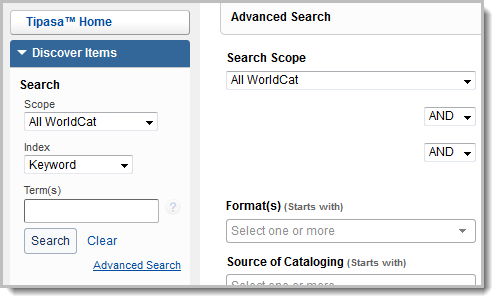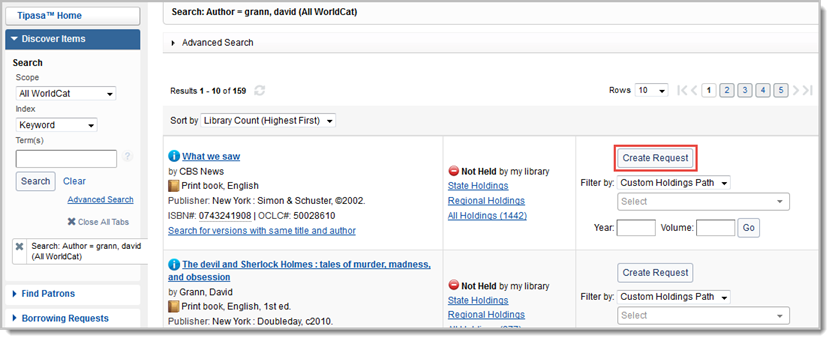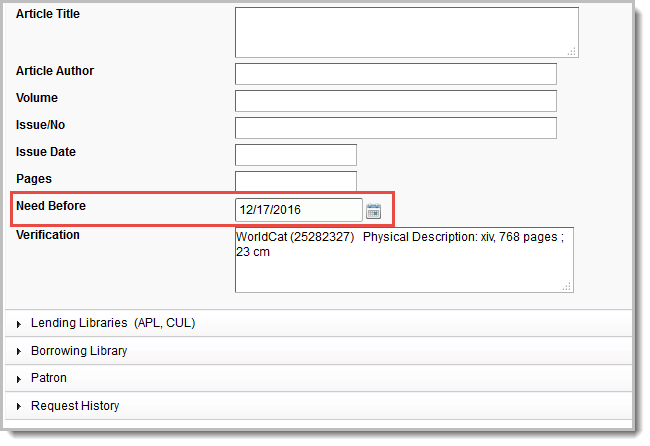Create and edit requests
Create Request (from a blank workform)
Create borrowing requests using Discover Items
You can search for items and create a request under Discover Items.

To discover items and create requests:
- Click Discover Items in the left navigation. When you open the Discover Items tab, an Advanced Search form also opens in the main panel of the screen. See Advanced search for additional information about this function.
- For a basic search, choose where you would like to search and the type of search from the drop-down lists at the top of the tab.
- Type your search terms in the box provided.
- Click Search. Matching results appear, along with holdings display options. When you click Search, the Advanced Search form collapses at the top of thee screen. Click Advanced Search to expand or collapse the form.
- On the Results screen, you may search or view items using one of the following options:
- Hover your cursor over the information icon (
 ) next to the title to see brief bibliographic data.
) next to the title to see brief bibliographic data. - If available, click the View Now link for open access resources. The resource will open in a new window.
- Search for versions with the same title and author by clicking the link. This will launch a new search based on title and author.
- To submit a new request, click Create Request. The request workform appears.
- Hover your cursor over the information icon (

- To display holdings, use one of the following options:
- Click State Holdings, Regional Holdings, or All Holdings
Regional Holdings includes all holdings in contiguous states.
- To display holdings from a Custom Holdings Path or Profiled Group, select that option from the Filter by drop-down list. Click Go to see results based on the selected filters.

See Holdings screen for more information.
- Click State Holdings, Regional Holdings, or All Holdings
- Use the Holdings screen to see information about the requested item as well as information about the available lendors. See Holdings screen for more information. Click Yes (or anywhere in the Yes box) to add a Supplier to your lender string.
- Click Create Request. The request workform appears.
- By clicking on the drop-down button next to Send Request, you can choose to Send Request or, if you have automations configured, Send to Automation. Sending to Automation allows you to submit a request without selecting lenders on the holdings screen or applying constant data, provided your automation is set to produce the request. Patron Status and/or Patron Department must be included if you are matching on patron data in your automation. Requests sent to automation are available in the Automation Produced queue.
- If the automation is set to Build Lender String or Send Request to Lenders, lenders in each Custom Holdings Group in the automation's specified Custom Holdings Path are sorted by turnaround time before being added to the lender string. Requests for articles from print serials will automatically exclude lenders who do not hold the year or volume of the requested item or who have a title-level deflection in the 008 of the LHR for the item. See Automated Request Manager for more information.
- Apply your constant data record in the Request work form using the Apply constant data drop-down list. Data in a field of a constant data record will always overwrite the value shown in the request; however, pre-existing patron data will not be overwritten. When a different Constant Data is applied to a record, the fields are briefly highlighted in green as a visual indicator of the change.
- On the request workform, provide a Need Before date (required).

- Under Borrowing Library, the Address field is required for both Shipping and Billing.
- Under Lending Libraries, lender policies are listed for any lenders you chose on the Holdings screen. To add more lenders, type the institution symbol(s) of up to 15 of your preferred lender(s) in the Lender String field, separated by commas.
- Under Patron, you will see an orange triangle with a Patron Not Linked message. Add the appropriate patron and link to their Tipasa account to allow the patron to receive email notifications and track the request in My Account. See Link a patron to the request for more information.
- If applicable, direct notes and supplier history, including reasons for no, will appear under Request History after the request is sent.
-
Click Send Request if the request is complete. A confirmation message appears and the request appears under the category Borrowing Requests > Produced > Awaiting Response. If you wish to save the request to submit in the future, click Save For Review.
-
Click Request ID in the confirmation message to search that request ID number.
- The request is re-displayed.
Holdings screen
Display holdings

To display holdings, use one of the following options:
- Click State Holdings, Regional Holdings, or All Holdings.
- State Holdings: Holdings within your state displayed in alphabetical order by institution name.
- Regional Holdings: Holdings from states or provinces that border your state. Bodies of water are not considered when determining borders. Your institution's state or province is listed first, followed by other states or provinces in alphabetical order.
- All Holdings: Your institution's state or province is listed first, followed by other states or provinces in alphabetical order.
Note: A line separates holdings for each state and province. Within each state or province, holdings are listed alphabetically by institution name
- To display holdings from a Custom Holdings Path or Profiled Group, select that option from the Filter by drop-down list. Click Go to see results based on the selected filters.
Holdings screen view

On the Holdings screen, you have several options:
- Hover your cursor over the information icon (
 ) next to the title of the requested item to see brief bibliographic data.
) next to the title of the requested item to see brief bibliographic data. - Click Yes (or anywhere in the Yes box) in the Supplier column to add a Supplier to your lender string.
- Once a lender has been added to the lender string, the hyperlink in the Supplier column will no longer be clickable. If a lender is removed from the lender string, your ability to click on Yes in the Supplier column is restored. This selection status will be maintained as you move through all holdings lists.
- Yes displays if the library is a current supplier. If they are not, a dash displays in the Supplier column.
- Click the information icon (
 ) next to the library’s name to go the OCLC Policies Directory and confirm a lender’s policies. The OCLC Policies Directory for the lender will open in a new window.
) next to the library’s name to go the OCLC Policies Directory and confirm a lender’s policies. The OCLC Policies Directory for the lender will open in a new window. - Click the library name to go to the library’s online catalog.
- This link is maintained in the WorldCat registry. For information about configuring your OPAC to display to other libraries and provide deep links to a specific OCLC number or other identifiers, see WorldCat Registry, Configure links to your online catalog.
- View suppliers’ Days To Respond. The Days to Respond indicates the number o fdays the library needs to respond to copy and loan requests.
- If an item is Held by your library, you will see the
 icon at the top of the Holdings screen, indicating that your library has a holding set on that item in WorldCat. You will also see this icon on the top of the Request work form.
icon at the top of the Holdings screen, indicating that your library has a holding set on that item in WorldCat. You will also see this icon on the top of the Request work form.
- If an item is Held by your library, you will see the
- View the suppliers Location, which displays abbreviations for the country, and state or provence.
- View the institution's OCLC Symbol.
- The Group column Group column populates when you filter by a Custom Holdings Path in order to show which of your Custom Holdings Groups contains a potential lender.
- The Cost column indicates what the library charges for copies and loans as entered in the OCLC Policies Directory.
- The IFM column will indicate Yes if the library participates in Interlibrary Loan Fee Management.
- View suppliers' Holdings information. This data is populated from the lending library's local holdings record or knowledge base holdings. If the information has been provided by the library, the column will display Local holdings available or a summary statement of specific volumes and issues held.
- Click on the text in the column to view additional holdings details.
- The resulting Holdings screen will list the Collection and Coverage for the knowledge base holding.
- Local Holdings Records will list the Format, Location, and Holding information.
- The coverage information displayed in the Holdings information sometimes comes from the embargo_info field of the KBART file in the WorldCat knowledge base. See Embargo and moving wall of coverage for more information.
The citation information for copy requests will display at the top of the Holdings screen and will remain as you scroll through potential lenders. Compare the lenders holding information in the Holdings column to the citation information of the copy request to be sure the lender has the exact volume needed to fulfill the request.
- Click on the text in the column to view additional holdings details.
Create request from an existing request
Edit borrowing requests
In some cases, it is possible to edit requests once they have been submitted. Following are scenarios where editing is currently allowed.
Editing is not allowed on closed requests.
New For Review requests
Edit bibliographic data via WorldCat:
- Navigate to Borrowing Requests > New For Review.
- Click the request ID to open the request.
- Click the magnifying glass icon, next to the Title, Author or standard number fields, to search WorldCat via Discover items.
- Click the item's title, then click Apply data on the bibliographic record. Alternatively, click a link to holdings, or use a Custom Holdings Path or Profiled group. Then click Update request on the Holdings screen. A confirmation message appears and the request is updated.
Send items through Automation:
Provided you have automations configured, you may send requests through automation. See Automated Request Manager. This option is available for any borrowing request that has not yet been submitted to lenders.
- Navigate to Borrowing Requests > New For Review.
- Click the request ID to open the request.
- Click on the drop-down button next to Send Request and choose to Send to Automation. If the request is produced with automation, it will appear in the Automation Produced queue. If it is not produced, it will remain in the list for staff review. You can check the Request History to see why it could not be produced, make further changes, and Send to automation again if appropriate.
Add lenders based on holdings:
- Navigate to Borrowing Requests > New For Review.
- Click the request ID.
- Click the View Holdings link to open the Holdings screen.
- Click Yes in the Supplier column to add a lender. The lender is added to your Lender String.
- Click Update request.
Produced requests
You may edit a Produced request that has not yet shipped by a lender in the following queues:
- Awaiting Response
- Automation Produced
- Conditional
Link a patron to the request
Under the Patron menu, add the appropriate patron and link to their Tipasa account to allow them to receive email notifications and track the request in My Account.
From the borrowing request:
- Under Patron, you will see an orange triangle with a Patron Not Linked message. Add the appropriate patron and link to their Tipasa account to allow the patron to receive email notifications and track the request in My Account.
- Enter the patron's name or Patron ID and use the magnifying glass to search for the Tipasa patron record.
- After you identify the correct patron, click their hyperlinked name.
- Click the Apply patron data to ILL Request button. The patron data is applied to the request.

- The following patron data is applied to the request if it is available in the Patron record:
- Patron ID
- Name
- Phone
- Address
- Address will only populate if there is no SMS text notification number and no email notification address available in the patron record.
- Pickup Location

